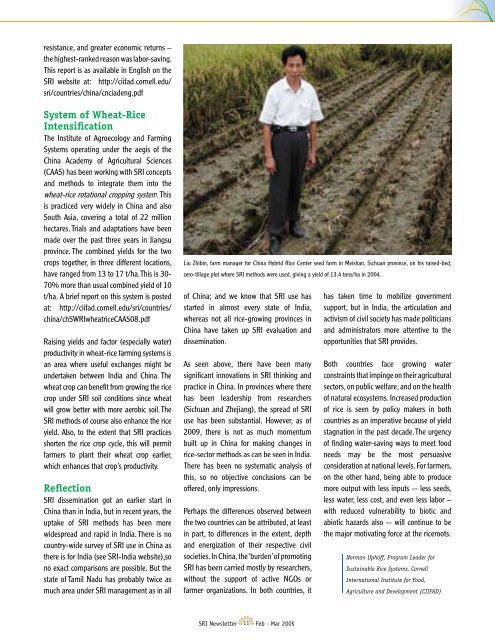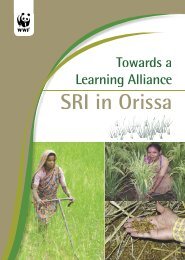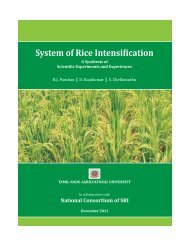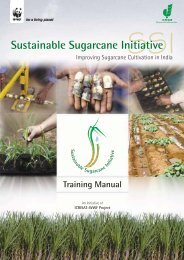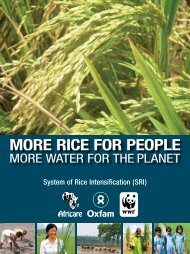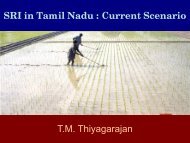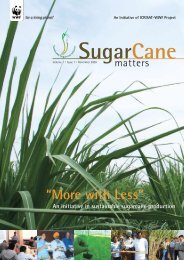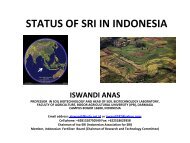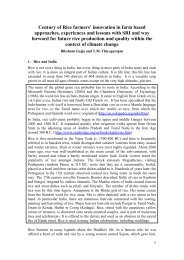Stretching Out SRI in Tamil Nadu - SRI - India
Stretching Out SRI in Tamil Nadu - SRI - India
Stretching Out SRI in Tamil Nadu - SRI - India
Create successful ePaper yourself
Turn your PDF publications into a flip-book with our unique Google optimized e-Paper software.
esistance, and greater economic returns –<br />
the highest-ranked reason was labor-sav<strong>in</strong>g.<br />
This report is as available <strong>in</strong> English on the<br />
<strong>SRI</strong> website at: http://ciifad.cornell.edu/<br />
sri/countries/ch<strong>in</strong>a/cnciadeng.pdf<br />
System of Wheat-Rice<br />
Intensification<br />
The Institute of Agroecology and Farm<strong>in</strong>g<br />
Systems operat<strong>in</strong>g under the aegis of the<br />
Ch<strong>in</strong>a Academy of Agricultural Sciences<br />
(CAAS) has been work<strong>in</strong>g with <strong>SRI</strong> concepts<br />
and methods to <strong>in</strong>tegrate them <strong>in</strong>to the<br />
wheat-rice wheat-rice wheat-rice rotational rotational rotational cropp<strong>in</strong>g cropp<strong>in</strong>g cropp<strong>in</strong>g system. system This<br />
is practiced very widely <strong>in</strong> Ch<strong>in</strong>a and also<br />
South Asia, cover<strong>in</strong>g a total of 22 million<br />
hectares. Trials and adaptations have been<br />
made over the past three years <strong>in</strong> Jiangsu<br />
prov<strong>in</strong>ce. The comb<strong>in</strong>ed yields for the two<br />
crops together, <strong>in</strong> three different locations,<br />
have ranged from 13 to 17 t/ha. This is 30-<br />
70% more than usual comb<strong>in</strong>ed yield of 10<br />
t/ha. A brief report on this system is posted<br />
at: http://ciifad.cornell.edu/sri/countries/<br />
ch<strong>in</strong>a/chSWRIwheatriceCAAS08.pdf<br />
Rais<strong>in</strong>g yields and factor (especially water)<br />
productivity <strong>in</strong> wheat-rice farm<strong>in</strong>g systems is<br />
an area where useful exchanges might be<br />
undertaken between <strong>India</strong> and Ch<strong>in</strong>a. The<br />
wheat crop can benefit from grow<strong>in</strong>g the rice<br />
crop under <strong>SRI</strong> soil conditions s<strong>in</strong>ce wheat<br />
will grow better with more aerobic soil. The<br />
<strong>SRI</strong> methods of course also enhance the rice<br />
yield. Also, to the extent that <strong>SRI</strong> practices<br />
shorten the rice crop cycle, this will permit<br />
farmers to plant their wheat crop earlier,<br />
which enhances that crop’s productivity.<br />
Reflection<br />
<strong>SRI</strong> dissem<strong>in</strong>ation got an earlier start <strong>in</strong><br />
Ch<strong>in</strong>a than <strong>in</strong> <strong>India</strong>, but <strong>in</strong> recent years, the<br />
uptake of <strong>SRI</strong> methods has been more<br />
widespread and rapid <strong>in</strong> <strong>India</strong>. There is no<br />
country-wide survey of <strong>SRI</strong> use <strong>in</strong> Ch<strong>in</strong>a as<br />
there is for <strong>India</strong> (see <strong>SRI</strong>-<strong>India</strong> website),so<br />
no exact comparisons are possible. But the<br />
state of <strong>Tamil</strong> <strong>Nadu</strong> has probably twice as<br />
much area under <strong>SRI</strong> management as <strong>in</strong> all<br />
Liu Zhib<strong>in</strong>, farm manager for Ch<strong>in</strong>a Hybrid Rice Center seed farm <strong>in</strong> Meishan, Sichuan prov<strong>in</strong>ce, on his raised-bed,<br />
zero-tillage plot where <strong>SRI</strong> methods were used, giv<strong>in</strong>g a yield of 13.4 tons/ha <strong>in</strong> 2004.<br />
of Ch<strong>in</strong>a; and we know that <strong>SRI</strong> use has<br />
started <strong>in</strong> almost every state of <strong>India</strong>,<br />
whereas not all rice-grow<strong>in</strong>g prov<strong>in</strong>ces <strong>in</strong><br />
Ch<strong>in</strong>a have taken up <strong>SRI</strong> evaluation and<br />
dissem<strong>in</strong>ation.<br />
As seen above, there have been many<br />
significant <strong>in</strong>novations <strong>in</strong> <strong>SRI</strong> th<strong>in</strong>k<strong>in</strong>g and<br />
practice <strong>in</strong> Ch<strong>in</strong>a. In prov<strong>in</strong>ces where there<br />
has been leadership from researchers<br />
(Sichuan and Zhejiang), the spread of <strong>SRI</strong><br />
use has been substantial. However, as of<br />
2009, there is not as much momentum<br />
built up <strong>in</strong> Ch<strong>in</strong>a for mak<strong>in</strong>g changes <strong>in</strong><br />
rice-sector methods as can be seen <strong>in</strong> <strong>India</strong>.<br />
There has been no systematic analysis of<br />
this, so no objective conclusions can be<br />
offered, only impressions.<br />
Perhaps the differences observed between<br />
the two countries can be attributed, at least<br />
<strong>in</strong> part, to differences <strong>in</strong> the extent, depth<br />
and energization of their respective civil<br />
societies. In Ch<strong>in</strong>a, the ‘burden’ of promot<strong>in</strong>g<br />
<strong>SRI</strong> has been carried mostly by researchers,<br />
without the support of active NGOs or<br />
farmer organizations. In both countries, it<br />
<strong>SRI</strong> Newsletter 11 Feb - Mar 2009<br />
has taken time to mobilize government<br />
support, but <strong>in</strong> <strong>India</strong>, the articulation and<br />
activism of civil society has made politicians<br />
and adm<strong>in</strong>istrators more attentive to the<br />
opportunities that <strong>SRI</strong> provides.<br />
Both countries face grow<strong>in</strong>g water<br />
constra<strong>in</strong>ts that imp<strong>in</strong>ge on their agricultural<br />
sectors, on public welfare, and on the health<br />
of natural ecosystems. Increased production<br />
of rice is seen by policy makers <strong>in</strong> both<br />
countries as an imperative because of yield<br />
stagnation <strong>in</strong> the past decade. The urgency<br />
of f<strong>in</strong>d<strong>in</strong>g water-sav<strong>in</strong>g ways to meet food<br />
needs may be the most persuasive<br />
consideration at national levels. For farmers,<br />
on the other hand, be<strong>in</strong>g able to produce<br />
more output with less <strong>in</strong>puts -- less seeds,<br />
less water, less cost, and even less labor –<br />
with reduced vulnerability to biotic and<br />
abiotic hazards also -- will cont<strong>in</strong>ue to be<br />
the major motivat<strong>in</strong>g force at the riceroots.<br />
Norman Uphoff, Program Leader for<br />
Susta<strong>in</strong>able Rice Systems, Cornell<br />
International Institute for Food,<br />
Agriculture and Development (CIIFAD)


